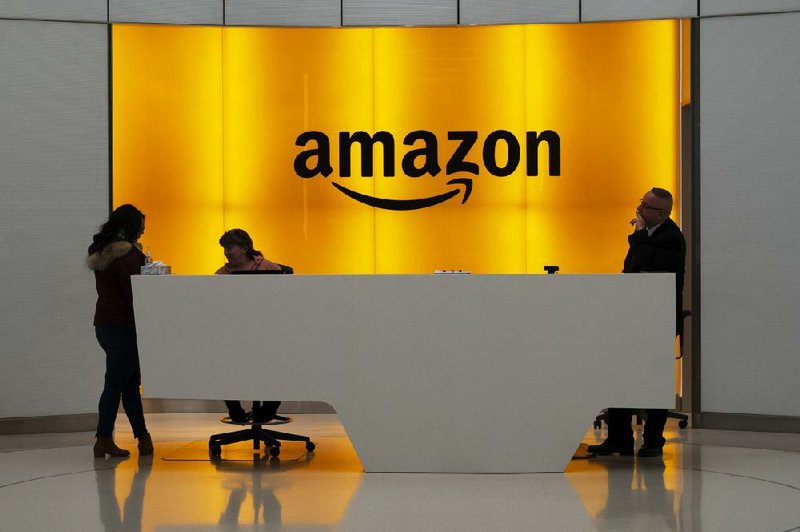NEW YORK -- In 2019, Amazon's U.S. workforce topped 500,000 for the first time, up 43% from the year before and more than triple what it was five years ago, the company said Friday. It gained 150,000 workers last year, more than the size of Apple's entire workforce.
When it reported its quarterly performance Thursday, Amazon revealed that 150 million people were paying to be members of its Prime service, which offers faster shipping and other perks.
On Friday, even while the Dow tumbled, Amazon shares soared passed $2,000 apiece, doubling in price in about two years. That puts Amazon among an exclusive club, Alphabet, Google's parent company, Apple and Microsoft, as a corporation with a value exceeding $1 trillion.
Amazon's growth comes with increased scrutiny. Some Democratic presidential candidates want to break it up. Others want it to pay more taxes. It is a regular target of President Donald Trump, who has been tweeting similar complaints as he fights with Amazon's founder, Jeff Bezos, who also owns The Washington Post. Amazon has said it shouldn't be broken up, and that it pays all the taxes it owes.
Being under the microscope has not slowed its phenomenal growth. Sales during the holiday season soared. Its other businesses, including cloud computing and advertising, grew, too, despite increased competition from other big tech companies.
Analysts at Benchmark said the results were a "not-so-subtle reminder Amazon is still king."
After retreating from a proposed new headquarters site in New York City because of local opposition, it has ramped up hiring across the country, including in New York City. Amazon said that it has 30,000 workers in tech offices outside of its Seattle home, in cities such as Chicago, Denver and Austin, Texas. That group of workers is up 50% in the past year and a half, Amazon said.
It also has increased hiring at its warehouses and delivery centers, where orders are packed and shipped.
Worldwide, Amazon had 798,000 employees by the end of last year. Only one American company beats Amazon in the size of its workforce; retail rival Walmart, which employs 1.5 million in the U.S. and more than 2 million worldwide.
"We are getting more efficient as we go," said Brian Olsavsky, chief financial officer, adding: "We're putting inventory in the right places, getting it closer to customers, and being able to handle it and transfer it more smoothly through network."
Olsavsky said that's part of what's driving sign-ups for Prime, which costs $119 a year for unlimited shipping, media services, discounts and other new perks, such as grocery delivery, which used to carry a $14.99 additional monthly fee that Amazon dropped last quarter.
Amazon expects first-quarter sales growth of 16% to 22%, to between $69 billion and $73 billion. It expects operating income to be $3 billion to $4.2 billion, which would be a decline, even at the high end, from the $4.4 billion posted in the first quarter of 2019. But Olsavsky noted that quarter was Amazon's most profitable, after a multiyear investment cycle.
Amazon still has more to do in 2020 to expand the availability of one-day shipping, which is expected to cost an extra $1 billion in the current quarter.
"We're still developing plans," Olsavsky said. "We do know the one-day shipping does put a lot of onus on us to continue to build our transportation capacity as well as our fulfillment center capacity."
Olsavsky added that Amazon expects to accelerate spending year over year on video and the data centers underpinning its Amazon Web Services.
While Amazon did not extend its financial forecast for the full year, Olsavsky's comments seemed to indicate a lower level of investment than some analysts were expecting.
Brent Thill, who leads tech sector coverage at investment bank Jefferies, said this was a key question hanging over Amazon's stock price going into the earnings report. While Amazon has long been willing to spend heavily in pursuit of new initiatives, investors still try to trim their stake in the company during periods of heavy investment.
"Everyone wants to drink the wine after it's picked rather than watching it grow," he said. "It's honestly that simple."
Amazon's business segment, largely composed of its fast-growing advertising business, saw sales rise 41% in the quarter to nearly $4.8 billion.
Sales at Amazon's portfolio of retail stores, including Whole Foods Market, were down 1% to nearly $4.4 billion. Olsavsky attributed some of the decline to the growth of grocery delivery, which more than doubled in the quarter from the year-earlier period.
"That's where a lot of the growth has been," he said. "We don't necessarily care that much whether it's in-store or delivered as long as we're meeting customer demands."
Information for this article was contributed by Joseph Pisani of The Associated Press and by Benjamin Romano of The Seattle Times.
Business on 02/01/2020
